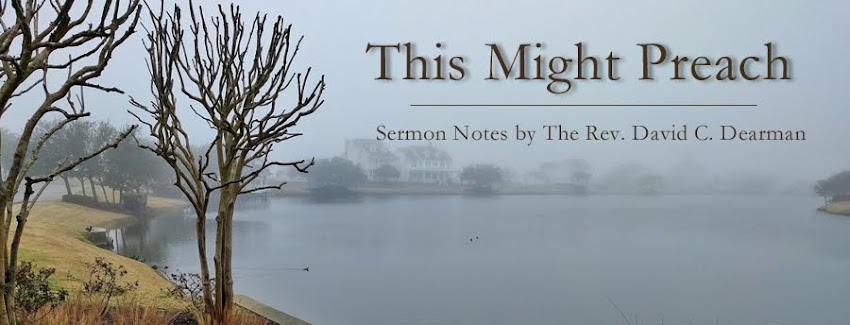28 April 2018
Grace Episcopal Church, Galveston
 Today we celebrate the marriage of Cameron and Megan. This is a first for me in that it marks the first time that I have had the honor to preside at the marriage of a former student of Trinity Episcopal School. I remember Gena and Gary Davis from those days...but you know, I don’t see the scrawny 6th grader. I’m just going to take his mother’s word that this burly, disciplined man who marries Megan today is actually the Cameron that I remember from 2006!
Today we celebrate the marriage of Cameron and Megan. This is a first for me in that it marks the first time that I have had the honor to preside at the marriage of a former student of Trinity Episcopal School. I remember Gena and Gary Davis from those days...but you know, I don’t see the scrawny 6th grader. I’m just going to take his mother’s word that this burly, disciplined man who marries Megan today is actually the Cameron that I remember from 2006!I’ve got 3 brief pointers to mention about marriage. I hope these pointers will be a solid guide for this couple’s future and I also hope they will resonated with the married folks who are here today to witness.
First, think with me about a definition of success in marriage. Cameron and Megan, I hope you will be careful when defining what success might be for you. No doubt you will work together to make all kinds of goals happen. Years from now you may find yourself with a beautiful, low maintenance house, two cars in the driveway, and 2.5 low maintenance children who are good looking and above average. Your Facebook page might show that the two of you just get more and more good looking and your news feed might show how well connected you are. Everyone on social media, including Cambridge Analytica, would see that you are a couple to be envied! My advice is that you be careful not to go too shallow when thinking about what success in marriage looks like to you. Try not to think about success in terms of what others think. The important opinions are those of the two of you. There is no one right answer but true success will more than likely be something that is non-tangible. Take curiosity for example. Another person is always a mystery. A young couple engages in a journey on which they are learning about one another...What are the places he would like to visit? What is her favorite memory from childhood? The list of things to find out about is endless...and even after spending a lifetime together, there is still more to know. In the end, all people are mysteries to one another. So my advice is “Stay curious my friends!” If even after growing old together as a couple, you are still curious about each other….well, that might be one way of describing a successful marriage.
Second, let me say a word about mistakes and disappointments. Go ahead and accept that these are going to happen. What matters is not so much that you make a mistake as it does how you recover from them. Marriage is not about perfection. Using Brené Brown’s definition, perfection is all about what others think. Remember, the important opinions are those of the two of you. Be humble enough to admit your errors to one another and be prepared to amend your ways. I’m kind of embarrassed to tell you about the first argument between my wife, Layne, and me. We had recently moved into married student housing at Sewanee. I was thirsty and was looking in the refrigerator for something to drink when I knocked over an open can of Sprite. The contents poured through multiple metal racks onto glass shelving, proceeding into a drawer of lettuce and other produce, before pooling under the lower drawers at the bottom. What a gross, sticky mess. I was angry. I knew whose fault it was….Layne’s of course. She left an open can on the shelf where I was reaching...that was “booby trapping” in my book. I do not remember the back and forth of the argument, but I saw in the end, that my anger was displaced. I was really mad at myself. I know now that whenever I start to blame someone else for some mishap, the most important thing is to hold my tongue until the cerebral cortex is back in charge. I think that the best school we have for learning not to be selfish is the institution of marriage. It takes work, but over time marriage can be transformational. The key is to be humble in front of one another. To be big enough to admit mistakes and to learn from one another.
Finally, let me say a word about joy. In the theology of the Church, mutual joy is the primary purpose of marriage. Don’t be a sourpuss couple. Make plans to do things that are fun. If you are blessed to have teenagers one day...do not be afraid to smooch in public sometimes just to embarrass them! Have fun figuring out what makes your spouse laugh. Beware of becoming much too serious about everything. Sometimes, you just have to stop and perceive that what life has thrown at you is totally ridiculous. In the end, you are responsible for your own happiness. In a way, being joyful is a choice...and the way to choose this path is to be thankful. Count your blessings. Revisit why you fell in love in the first place, and be grateful for those qualities in one another. There is a time for everything under heaven, and sometimes it is the time to grieve. When this is the case, grieve together. Help bear one another’s burdens. Pray and worship together. Share each day something for which you are thankful. Sometimes, it is good just to be silly. Never forget that God’s wish for you is mutual joy. AMEN.




